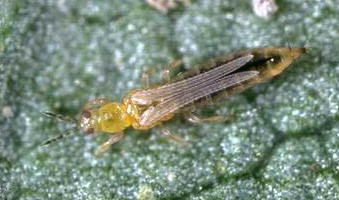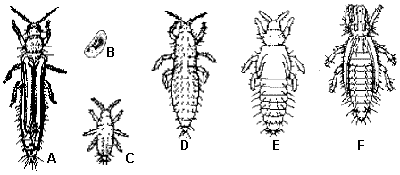|
|
Back to Pest Identification and Diagnosis
WESTERN FLOWER THRIPS
SCIENTIFIC NAME: Frankliniella occidentalis (Pergande)
CLASS: Insecta
ORDER: Thysanoptera
FAMILY: Thripidae
 |
 A. Adult B. Egg C-D. Larvae E. Prepupa F. Pupa |
|
|
Adult Western Flower Thrips From: University of California |
Life Cycle From: NC Extension |
| DESCRIPTION | |
|
Adults: Western flower thrips is about 1 mm long, with the female larger than the male. The female varies from yellow to dark brown, and has a more rounded abdomen. The male is always pale yellow and has a narrower abdomen. Eggs: Yellowish eggs cannot be seen because they are laid into the plant tissue. Larvae: The larvae develop through two instars and are distinctly yellow. Second instars become whitish prior to molting. Prepupae and Pupae: Both prepupa and pupa are yellowish, quiescent non-feeding stages. The antennae and wing pads are typical for most thrips species. |
|
| BIOLOGY | |
|
Distribution: The distribution was thought to be limited to west of the Mississippi River prior to 1980. However, this thrips has become the most prevalent species attacking greenhouse flowers throughout the United States and Canada, and many countries in Europe and Asia. Host Plants: This thrips feeds on almost any flowering plant. Carnations, chrysanthemums, gerberas, geraniums, marigolds, pansies, and roses are the major host plants. Damage: The western flower thrips feeds on the flowers and foliage by inserting its modified left mandible into the tissue, and sucking the fluids from cells. Oviposition and feeding scars reduce the aesthetic quality and marketability of ornamental plants. When thrips feed on developing tissues, affected cells are unable to expand, and mature leaves and petals are distorted. When thrips feed on expanded tissue, effected cells become filled with air, which imparts a silvery appearance. This thrips also is an important vector of tomato spotted wilt virus and impatiens necrotic spot virus. Life Cycle: Females lay eggs in tender plant tissue. The eggs hatch in 2 to 14 days, depending on temperature. First instar larvae begin feeding on egg eclosion. Second-instar larvae also feed on plant tissue, usually in flowers. These larvae are found in the protection of perianth of the flower or within developing terminal foliage. Late in the second instar they stop feeding and move down the plant to pupate. Thrips develop through two quiescent, non-feeding pupal stages in the soil, plant litter or in a protected area on the plant. Adults emerge and resume feeding on flowers, buds, and terminal foliage. The entire life cycle from oviposition to adult emergence can take 12 days in hot weather to 44 days in cool weather. |
|
| CONTROL | |
|
The thrips are difficult to manage with pesticides because of their thigmotactic behavior causes them to feed deep in the flowers and buds where they are sheltered from chemicals. Chemical management of western flower thrips has received much attention, but control remains difficult. Natural enemies have been investigated and biological control programs using insidious plant bugs and predaceous mites in the genus
Amblyseius have been used in greenhouses. Screening has been shown to effectively exclude western flower thrips. |
Back to Pest Identification and Diagnosis
 |
(C) Regents of the University of
Minnesota. All rights reserved. |
 |
 |